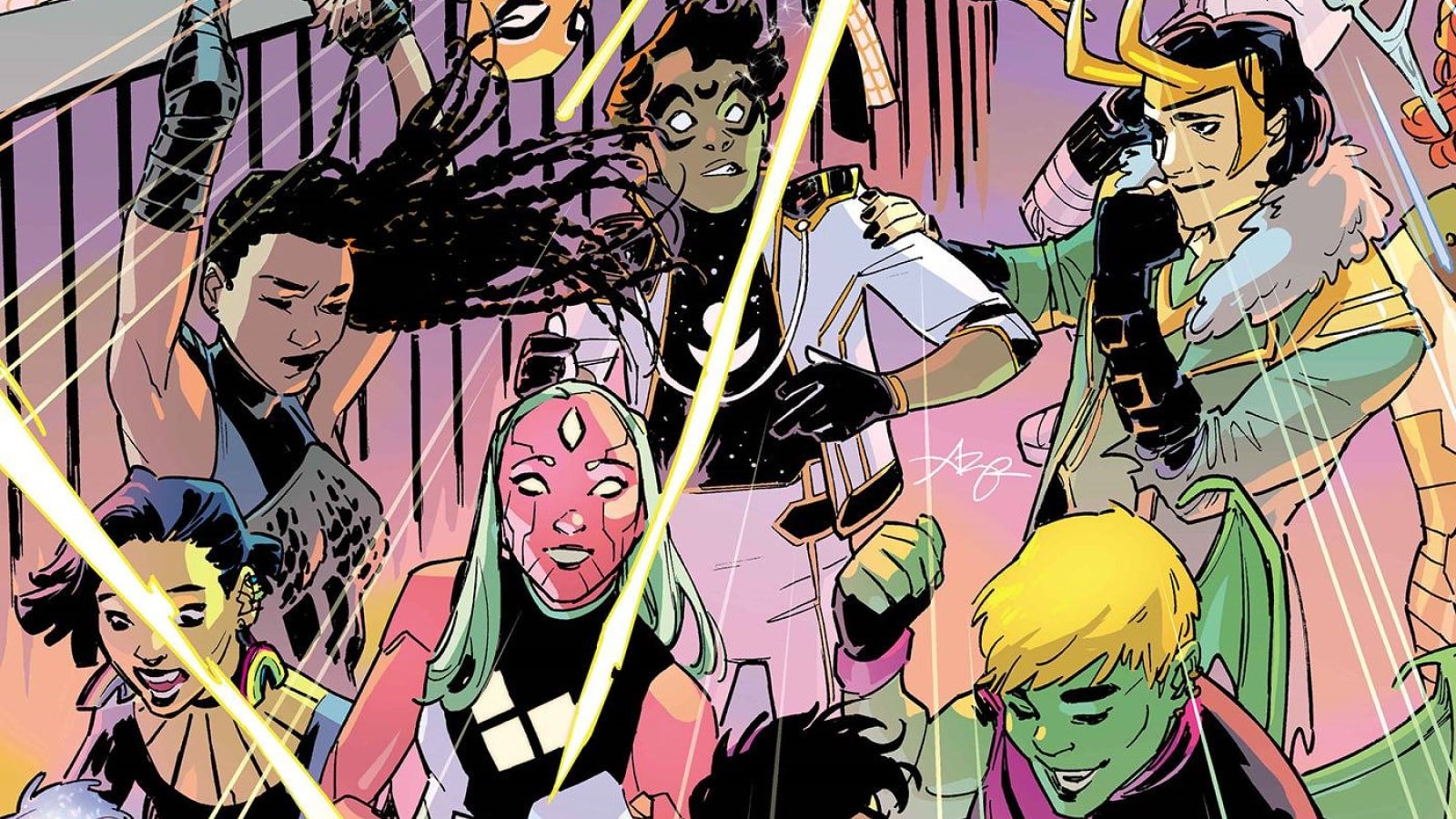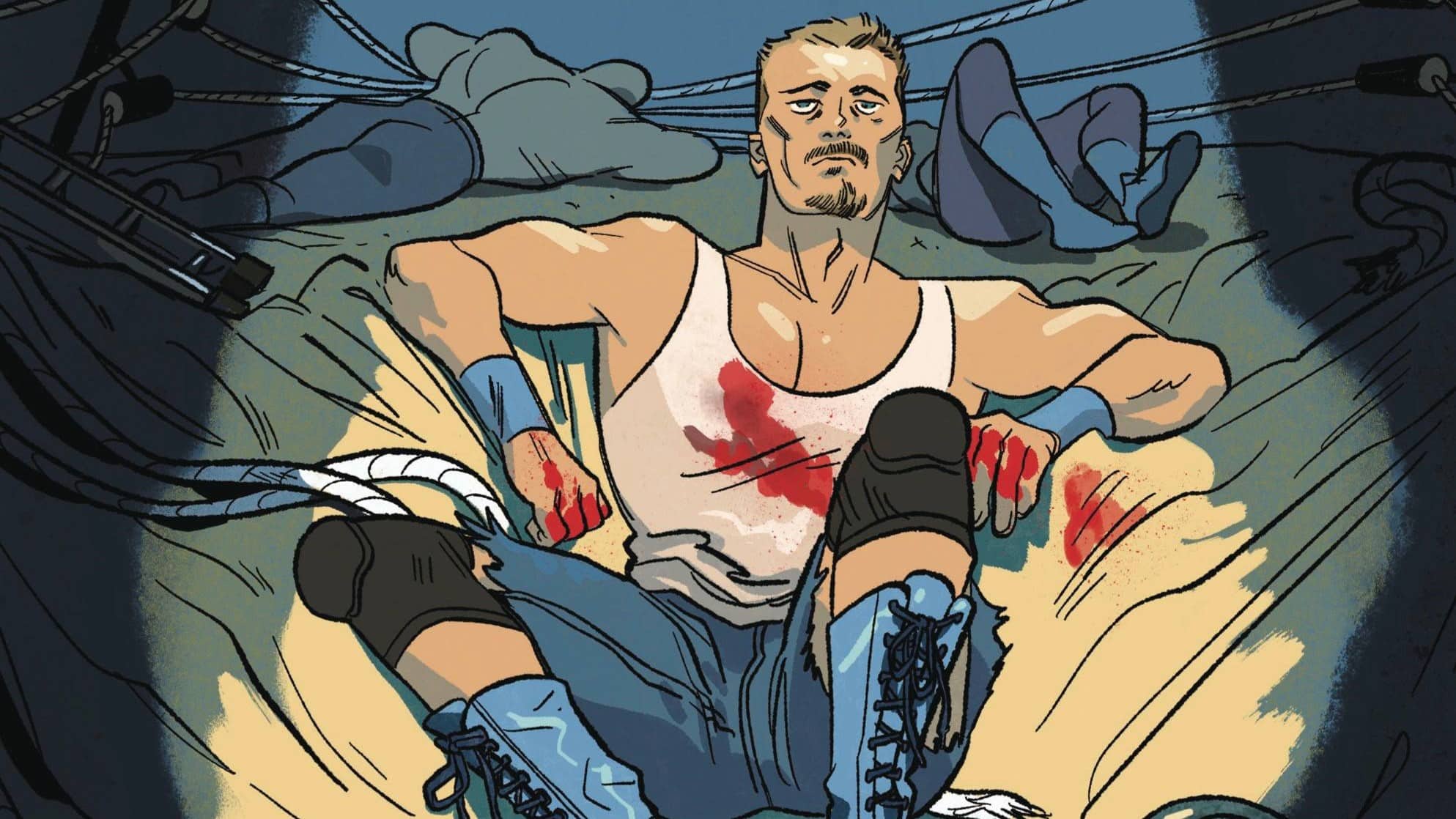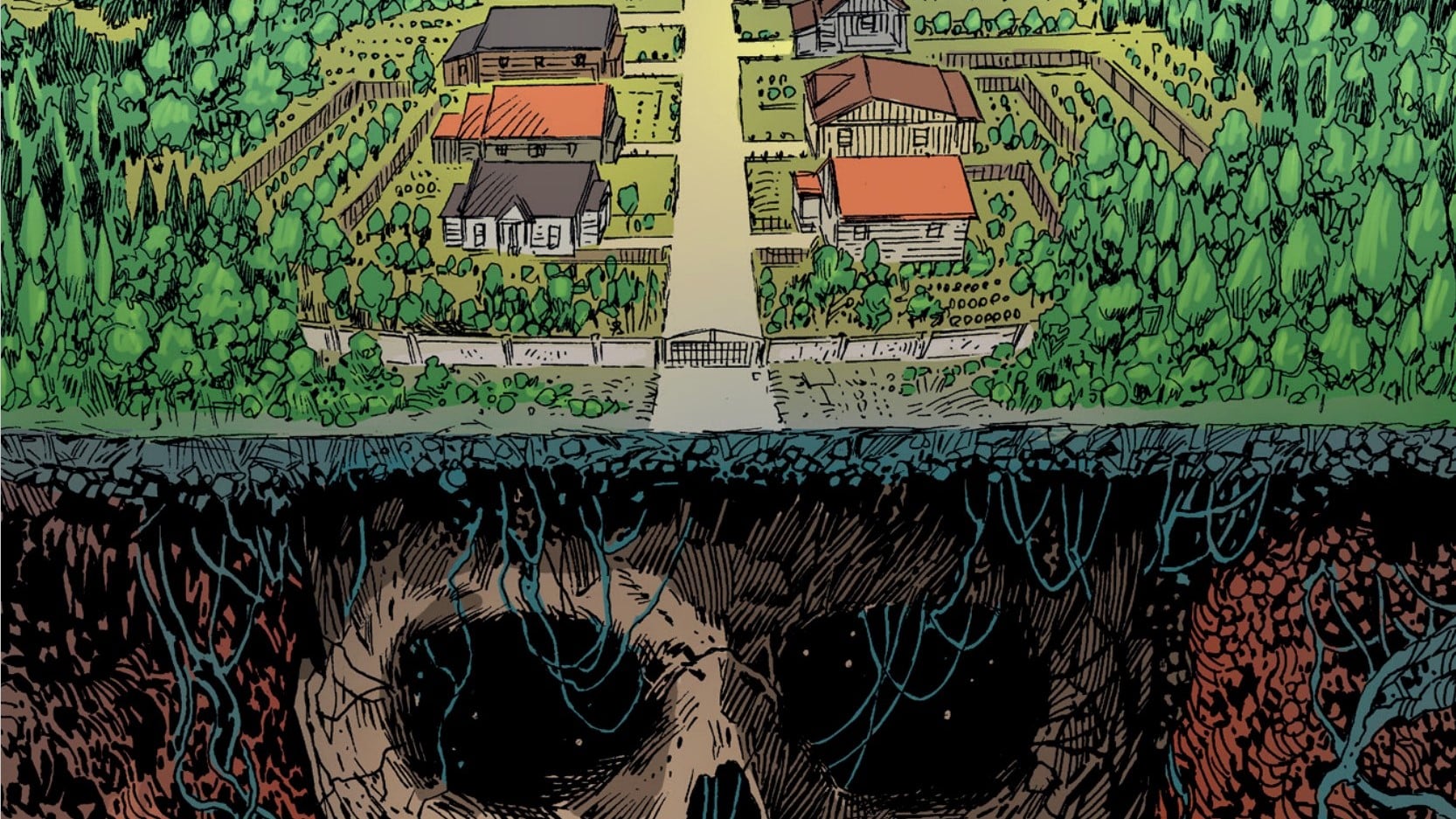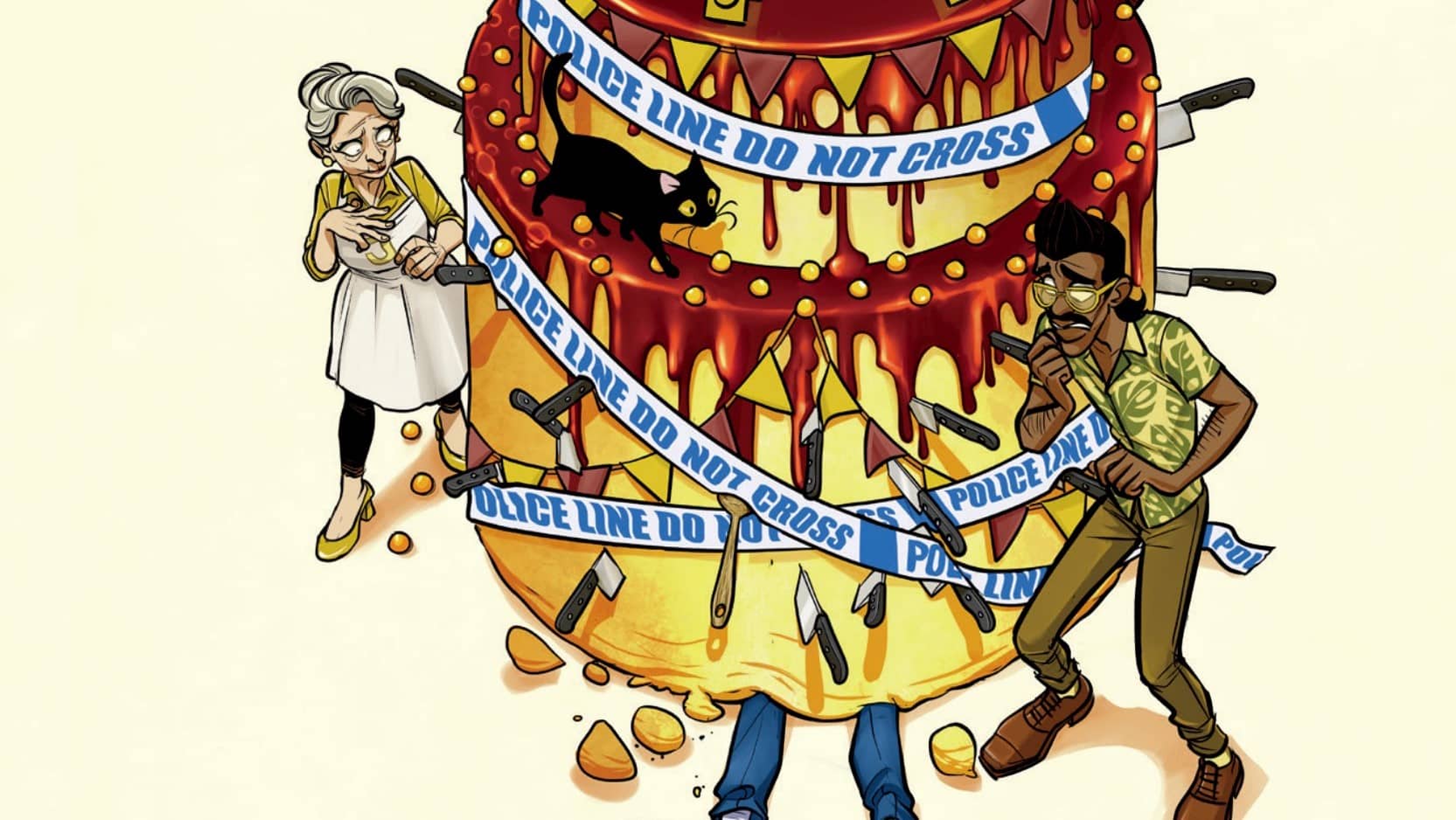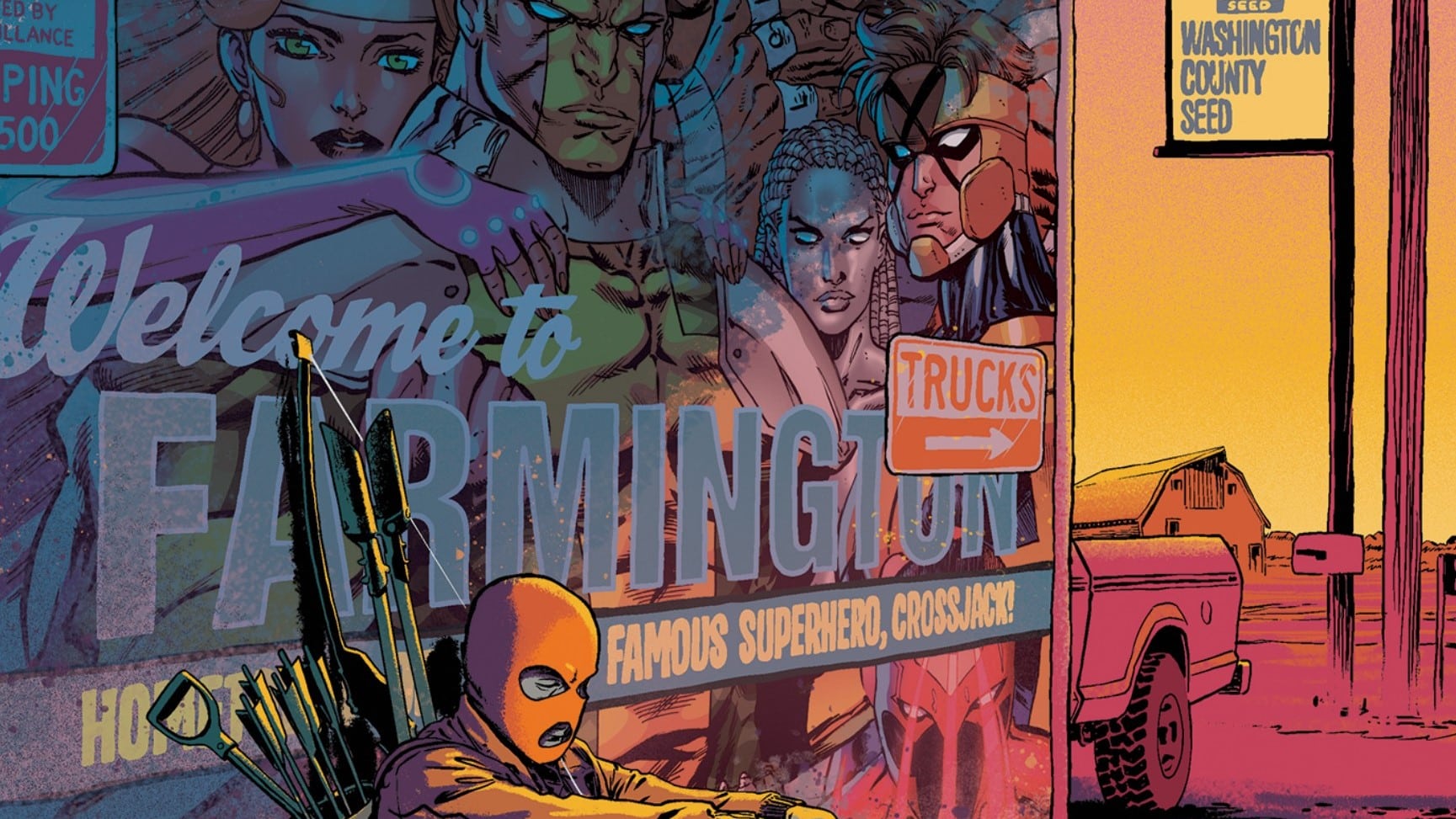Stephanie Burt: Yeah, we’re late. I’m late. I know. At least it’s still June, which means we’ve still got time to look at this year’s attempts by both of the Big Two to pursue the pink pound, gain gay ganache and generally roll out a big welcome mat in rainbow colors, while claiming they’ve always been sorta gay. I had fun with all three (Yes, there are three this year) offerings, but. But but but. Sean, do you think Marvel’s sending their best? Do you want to embark on the dangerous game of comparing the two?
Sean Dillon: A joke a friend of mine occasionally makes is to ask whether they want to be represented by the Disney Corp. I’m basically only here because there’s a charming Grant Morrison comic in this bunch. Otherwise, these collections remain largely basic with occasional moments of brilliance and crap.
Stephanie: I’ve literally never written about a DC comic for this site. I’m not sure I’ve written about one ever, unless you count poems about the Legion of Super-Heroes — which, by the way, gave us the first trans supporting character in mainstream comics, Element Lad’s gf Shvaughn Erin. We don’t see Shvaughn, or indeed any LoSH content, in DC’s first-of-its-kind historical annual, DC Pride Through the Years, but we do see three important LGBTQ+ stories from DC’s past, all of which are more fun and better written than Northstar’s so-bad-it’s-good infamous coming out scene in Alpha Flight #106.

First we get the 1991 Flash story where the Pied Piper comes out. It’s aged … shockingly well! Wally West, who is the Flash at the time, wants to know if the Joker is gay, and the Piper — drawn with soft features, a stocking cap and a generally nonthreatening fairy-tale vibe — has answers: “I doubt he has real human feelings of any kind. … He’s not gay, Wally. In fact I can’t think of any super-villain who is. … Well … Except me, of course. But you knew that, right?”
And Wally, his mask off, his orange hair typically tousled, looks … uncomfortable, and takes a while to process it, giving it a couple of thought balloons while zipping off to hang out with Kal-El. That’s how it looked when queer adults came out to well-meaning cis straight adults in the late 1980s and early 1990s. Cis straight adults (Don’t get me started on teens back then) often thought they knew no one gay: Our mere existence, right under their noses, came as a mild shock — one they could, with a bit of time, absorb. Which is what Wally does.
Sean: In many regards, The Flash #53 is very much an issue of The Flash with a character moment in which a supporting character comes out. It’s not the focus of the issue, which weakens it in the context of this small collection. It might have been better to have a story that focuses on Pied Piper here instead of the one where he comes out. To put it another way, the next issue explored isn’t the issue of 52 where Batwoman is introduced as a lesbian, but rather an issue that focuses on her as a character.
Artistically, it looks very ’90s. Not in the sense of a book where it’s all pouches and muscles and chains, but rather one where the art is more mercenary in nature rather than the star of the book, as often happened at DC at the time. There was a reason why many of the superstar artists who founded Image were working at Marvel. There weren’t a lot of great artists being found at DC at the time, a major contrast to the modern era of art in comics.
Stephanie: Flash #53 looks historical. Batwoman/Detective Comics #854 (2009) looks beautiful and contemporary: big jagged panels; red, white and black for pages at a time; and Kate Kane having Relationship Bat-difficulties. Her partner Anna’s had enough: “Call me when you’ve decided to grow up.” Greg Rucka writes a good breakup, and a better fight scene, but the real magnificence comes in the visuals from J.H. Williams III with Dave Stewart on colors: Kate’s moody breakfast and Kate’s super-goth later conflict — with an Alice-in-Lolicon, pale-as-milk villain — look like they come from different universes. Both beautiful, both kinda gay.
Sean: Williams remains the best thing that DC ever wasted. The collective history of Batwoman (and especially Williams’ Batwoman) is far too long and miserable to get into here. And it harkens to the nature of the book: This is DC Comics going through their catalog and finding marketable stories about queerness and superheroes to sell as their legacy.
Stephanie: Then there’s Supergirl #19, a well-done after-school special of a story in which Kara defends, and befriends, the nonbinary teen Lee Serrano, whose coming-out story occupies most of the 2018 issue. Lee and Supergirl chat — of course — about standing out, and not fitting in, and learning to accept help and to be yourself: “When I first got to Earth, I didn’t know the culture, the languages. People were scared of me, hated me, too. I was so angry, so confused …” It’s a familiar metaphor, but it works: It’s easy to imagine nonbinary readers, in particular, five years ago, feeling seen. It’s also easy to imagine Vita Ayala, who co-wrote the story with Steve Orlando, placing their younger self on a rooftop with Kara and wondering what they’d say.
All three stories feel historical in a particular sense: They’re stories where the mere existence of a gay or queer or trans or nonbinary person in a mainstream comic book is cause for celebration (and for trolls’ concern): LGBTQ+ presence in itself makes the issue worthy of note. The epilogue to DC Pride Through the Years, a mostly-in-retrospect Alan Scott/Green Lantern six pager, remains historical in another sense: It’s set in the Golden Age past (and introduces a forthcoming Alan Scott miniseries). They’re also stories where — except for Alan Scott, if he counts — the LGBTQ+ character isn’t a headliner, exactly. Kate Kane comes close, as part of the Bat-Fam, but she was a groundbreaking, pre-Iceman near-exception to the rule that said supporting characters, new characters, characters without an existing fan base could turn out as queer as, well, me, but marquee heroes had to stay plausibly straight.
Sean: And yet, there are limits to this history. For all that there is the loving tribute to Rachel Pollack in the main Pride special, there’s not a single story from that seminal run here. Coagula doesn’t get a mention at all in this “Pride Through the Years.” Nor do the blatantly queer works of William Moulton Marston, the butch Ma Hunkel or anything by Grant Morrison. It’s all the things that can be easily packaged in a collection for people. The history of queerness in DC Comics starts in the ’90s, when it’s been there for much longer.
Stephanie: Have things changed? Yes and no, to judge by Marvel Voices: Pride 2023. This third in the annual rainbow-flag anthology series … well, it isn’t the largely stellar 2022 edition, which introduced Escapade. Or the 2021 edition, which finally brought back Jessie Drake.
Sean: Honestly, what hurts the collection quite a bit is, well … it’s extremely mid when it comes to the art. I want to love a collection where Gwenpool uses the fourth wall to fight gatekeepers or Black Cat woos a goddess. But the art doesn’t do the book favors. A lot of it looks like, as my good friend Ritesh described it, the work of some Stuart Immonen imitator named Martin Macaroni. As such, I couldn’t get into any of these stories like I could for the previous DC Pride Through the Years or even the main DC Pride for 2023. I wish it was more fun.
Stephanie: It isn’t a showcase nor an effective launching pad for new queer authors or queer characters. Closest to such a thing is Stephanie Williams and Hector Barrios’ extended multigenerational origin story for a new version of Nightshade, set at a family reunion, and I’d love to see more of the character but I’m not sure this story will draw in the readers it needs: It ends up stiff and heavy on exposition. I hope this character — Logan Lewis-Johnson — gets another Marvel chance, and that experienced scribe Williams gets another chance to write her.
Wiccan and Hulkling — of course! Are they in every Pride issue? At every Pride party? Feels that way — go on a road trip and/or belated honeymoon in Shadi Petosky and Roberta Ingranata’s “Everywhere,” set in a version of rural Montana that my friend from rural Montana noped out on immediately. Our green and white couple encounter “Lacie Lorraine,” a “clearly transgender cowgirl-ish Montana gas-station attendant” whose pronouns are “she/her/howdy!” Who is a Skrull. And “prone to infodumpin’” (no g). And sad about being a trans Skrull, despite her shape-changing ability, because after death, her corpse will “revert to a sex I barely remember. … I need to die female.” That’s why she seeks, and gets, gender-confirming technology. From a Celestial. Also ADHD medication. I am not making any of this story up. It’s fun, but it feels like satire directed at earnest trans stories that mostly have yet to be written (except as fanfic), and honestly: It’s too soon, and it’s not a good look.
Nor, I’m afraid, is Muzzle, part of “a Robin-Hood-esque, queer, human, anarchist crew who live and work together” and who break into a lab to steal the hormones so many trans folks can’t get, nor afford. Spider-Man tries to stop them, announcing, “You can’t just take things that don’t belong to you.” But Spidey’s wrong: When giant companies hoard the things and real people need them to live, sometimes you can and sometimes you should, if you can get away with it, which non-powered people usually can’t. Oh, also Muzzle’s kinda gross — big tongue, sticky fluids — and probably a Venom-related symbiote. H.E. Edgmon, Lorenzo Susi and Kelly Fitzpatrick on colors do their best, but as with the Nightshade and Lacie Lorraine chronicles, the story seems satisfied to announce, and to celebrate, the existence of these queer and trans boundary-breakers: They’re here, they’re queer, that’s great as far as it goes, but the plots don’t give them much else — as yet — to do.
Also here, and also promising, but not quite fulfilling, because they’re just announcing their queer presence, prepping the ground for future adventures: Spider-Verse fashion plate Web Weaver, in a story about a Purim carnival that I’m going to have to leave for people who haven’t been ground down by Jewish Sunday school (j/k n/k, but our current shul suits our family fine); Gimmick, from Vita Ayala, Bernard Chang and Paco Medina’s Children of the Atom, now in a new team of mutants on Krakoa. I’d love to see more of Gimmick. And of Ayala.

You know what looks more than promising, though? As good as anything in the Distinguished Competition’s otherwise stronger Pride issue? The best of the Marvel Pride art. That would be the first mini-tale here, in which the redoubtable, enthusiastic, attention-seeking Gwenpool comes out as “asexual and aromantic! So I decided to be … the ace icon of the Marvel Universe! And look at me. I’m in a Pride comic!” Beats dating Quentin Quire. By a mile. And, more seriously, I love it. Marieke Nijkamp gets Gwen’s voice just right — I’m still amazed at Nijkamp’s lighthearted comics style, given the grimness of her last fantasy novel, but she’s given Pablo Collar and colorist Michael Wiggam everything they need for Gwendolyn Poole to pop out of her pink socks and ace up the place. These panels of hugs and Dazzler dances and word balloons given physical form rock at least as hard as previous Poole-pencillers Gurihiru and David Baldeon have done, and that is really saying something. Gwenfans: queue to the left.
As for X-fans: queue at the velvet rope. “Jumbo Carnation’s Ultimate Creations” is barely a story, but so what? Auteur Stephen Byrne (Green Arrow, Serenity, various video games) shows a confident Jumbo, both forewarned and four-armed (I’ll show myself out now), creating Hellfire Gala runway looks for America Chavez (“Boricua Realness”), Viv Vision (who looks like an actual teen, super-awesome and not inappropriately sexualized), Northstar (a black-and-white coat-and-tails to die for), and of course a man who “can shatter my star any day.” They’re pinups, in the very best sense of the word. And these comics — well, they’re queer images. And they’re fun. But for queer stories? Wait till next time, when we cover this year’s DC Pride.

